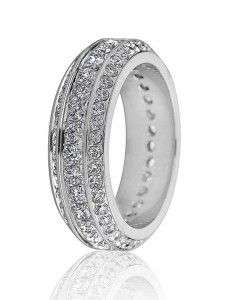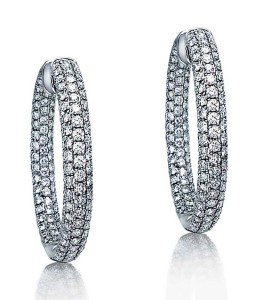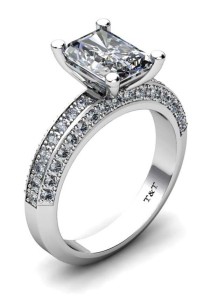Savvy seller: How you can sway consumers from online diamond competitors
by charlene_voisin | August 1, 2012 9:00 am
 By Jeff Green
[1] [2]
[2]
There’s no such thing as an inexpensive diamond. Quality has always been the cornerstone of successful jewellers, and in the face of fading market share to online competitors, retailers should consider keeping it old school.
“If you want to imitate the Internet, you’ll never win,” says Mel Moss, president of Regal Imports.
Moss, like many wholesale diamond suppliers, has seen the stones that end up online. They’re the ones he passed over, diamonds that Moss says, have “squeaked by” the grading system.
They’re less expensive for a reason, and, as Moss affirms, it’s up to retailers to return to their roots as diamond experts and avoid being an “order taker.”
The sight of a customer that comes prepared with quotes of diamonds from the web should not be a deterrent; rather, it’s a good sign. The client is in your store, and wants to talk to you about diamonds. Half the battle has been won.
Salvaging the scraps
 [3]
[3]Years ago, Ami Freiberg of Classic Creations Jewellers in Toronto would buy certified diamonds sight unseen. Today, he prefers not to do so. Both Freiberg and Moss say a grading certificate is just an opinion. There’s room within any grade at the good end and the bad, something consumers are likely not to know or understand.
John Anderson, owner of Davidson’s Jewellers in Ottawa, echoes the sentiment, adding consumers armed with online prices frequently come to his store looking to negotiate. He says his answer is straightforward.
“In some situations, if a consumer questions price or something like that, I’ve mentioned that some of these online sites are being used as clearing houses,” Anderson says. “Basically, they are clearing out merchandise that was not purchased by jewellers. That should tell the consumer something.”
Online retailers don’t hold any physical inventory. In addition to other operational aspects, these companies’ expenses are significantly less, which means their prices are much lower than brick-and-mortar retailers.
The trick for retailers is providing consumers with the knowledge they need to recognize the value in dealing with a sales associate across a counter, rather than a voice on the phone or a live chat.
“The illusion is the consumer is buying from a diamond dealer who is an expert, but they’re not,” says Albert Wizman of Toronto-based Wizman Gems, a diamond wholesaler. “The online site is a broker, and the diamonds are being sold through them. They’ve never looked at the diamond and probably never will.”
Who’s the expert?
 [4]
[4]If the wave of online purchasing has taught traditional retailers anything, it is the reminder that diamonds are far from a commodity.
“We ourselves, even as gemmologists and professional jewellers, don’t purchase a stone sight unseen,” Anderson says. “The client should also be doing the same thing.”
Moss sees the issues at a deeper level.
“Can (diamonds) be bought blind? Or do they need to be looked at and discussed?” asks Moss. “Can consumers be experts by reading a few articles and spending an hour online? Who’s supposed to be the diamond expert?”
Returning to the roots of diamond retailing—where a trusted expert explains the difference in cost beyond the certificate—is the key to competing with the rock bottom online prices, says Moss.
“The value-added of going to a retailer is the knowledge they bring to the equation, and if the retailer does not bring a specialized product or knowledge to the table, then there is no reason why somebody shouldn’t buy blind,” he adds. “If you haven’t invested the time learning the product, your customer certainly has. They may throw you a question you don’t understand, and you could lose a sale to some Internet site.”
Wizman notes that when a consumer is only interested in matching the price of an online broker, it is up to the retailer to explain the grading report. For instance, the position of inclusions greatly affects price, which is something most consumers fail to appreciate. This is a prime opportunity for the retailer to show the customer examples of how a diamond they’ve found online compares to a similarly graded stone right in front of them.
Freiberg says it is common to find him explaining the absence of quality in discount diamonds.
“A lot of the time, we’ll have clients who have come in here with diamonds they bought online and don’t understand why their diamond is dead compared to ours,” Freiberg says. “Well it’s dead because it has a huge cloud in it”¦ It’s a matter of educating the consumer more than anything else. When they’re here, that’s the best time to educate them.
“A lot of jewellers today don’t understand buying diamonds—they understand buying paper, and that’s a mentality that has to change within our industry,” he continues. “You don’t buy paper, you buy diamonds. And if you’re buying paper, you’re not a professional jeweller in my opinion.”
It’s a strong sentiment, but a consistent one across the board.
“You must specialize in something that isn’t just about price,” says Moss. “All you’re doing is giving away your expertise, giving away your profit, giving away everything in order to [make the sale].”
Hope in the mirror
 [5]
[5]Reflecting on the past is one way retailers can compete in the future.
“As a retailer you don’t market price, you market quality,” says Moss, adding he’s repeated this to his clients many times before. “You separate yourself. There’s always going to be somebody cheaper than you and, certainly in the case of the Internet, there is someone cheaper than you because they have no overhead.”
It’s also vital to recognize the work the consumer has done, though in a positive way. It keeps the possibility of future sales in the mix, Anderson explains.
“I have had a few situations, just like everyone else, where we have lost a sale to the Internet,” he says. “But interestingly enough, the same people returned to the store and ended up buying their wedding bands with us—at full price, without a discount.”
If, however, the retailer cannot win over a consumer fixated on price, Wizman notes there still value in keeping them in the store, and selling for the future.
“So you didn’t hit a home run with the diamond ring,” Wizman starts. “Build the relationship for next time. It takes months to make a customer; it takes seconds to lose one.”
 [6]
[6]His advice is to look at the long-term potential. A retailer may not make much profit if he has to match the price of an online dealer, but offering to design and make the mount is an avenue for future sales and creating a lasting relationship with the client.
“There could be diamonds in the mount. And what about the diamond wedding band that comes down the road? What about winning over the customer for when they want to buy other jewellery?” asks Wizman.
It’s not an ideal situation, he acknowledges, but the retailer may gain a client. After all, they came to you, regardless of the online quote with which they may have brought with them. While they may have been using the quote as a bargaining chip to negotiate a better price, they also came to see the product and start a conversation with the person they may see as a diamond expert.
“The best costs more to make,” Wizman says. “I would rather explain the quality, than apologize for absence.”
Jeff Green is a Hamilton-based journalist and freelance writer. He’s covered breaking news, business, and sports for daily and weekly newspapers, as well as for the Canadian Press. Green was nominated for a pair of Ontario Newspaper Awards for his work in this, his first year as a full-time journalist.
: http://www.jewellerybusiness.com/wp-content/uploads/2012/08/Opener_ftbu.jpg- [Image]: http://www.jewellerybusiness.com/wp-content/uploads/2012/08/opener_savvy-2.jpg
- [Image]: http://www.jewellerybusiness.com/wp-content/uploads/2016/02/POS-131.jpg
- [Image]: http://www.jewellerybusiness.com/wp-content/uploads/2016/02/catalogue-003.jpg
- [Image]: http://www.jewellerybusiness.com/wp-content/uploads/2016/02/10.jpg
- [Image]: http://www.jewellerybusiness.com/wp-content/uploads/2016/02/fancy2.jpg
Source URL: https://www.jewellerybusiness.com/features/savvy-seller-how-you-can-sway-consumers-from-online-diamond-competitors/